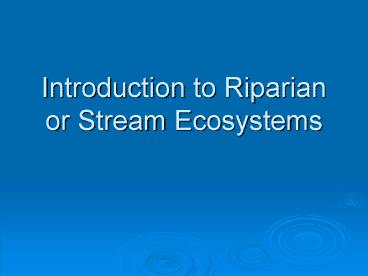Introduction to Riparian or Stream Ecosystems PowerPoint PPT Presentation
1 / 59
Title: Introduction to Riparian or Stream Ecosystems
1
Introduction to Riparian or Stream Ecosystems
2
(No Transcript)
3
Vandalia, IL 2004
4
Cave Creek (Lake County, Ohio)
5
Jarbridge, northern NV
6
Rio Puerco (USGS)
7
Fundamental Principles
8
Newtons 1st Law of Motion
- The momentum of a body remains constant unless
the body is acted on by a net force (conservation
of momentum)
9
1st law of Thermodynamics
- Energy is neither created nor destroyed
(conservation of energy)
10
Conservation of Mass
- Mass is neither created nor destroyed
11
Conservation Equation
- Derived from the Newtons first law of Motion
(applied to momentum), first law of
thermodynamics (applied to energy), and the
conservation of mass - Conservation equation can be expressed in a
number of ways, but can be simplified to
amount in amount out change in storage
12
Water Balance Equation
- P Gin (Q ET Gout) ?S
- Where
- P precipitation (liquid and solid)
- Gin ground water in
- Q stream outflow
- ET evapotranspiration
- Gout groundwater out
- ?S change in storage
13
Assumptions
- Make Gin negligible
- Runoff can then be viewed as the residual between
two climatically determined quantities (P and ET)
14
ET
P
Gin
Gout
Qout
Gout
Modified from FISRWG, 1998
15
Runoff and Base Flow
- Runoff represents water potentially available for
use, forms the basis for regional water
management - Runoff represents the sum of overland flow,
interflow, and storm flow, and occurs when the
soils infiltration capacity is exceeded - Base flow is the sole source of water sustaining
river flow in periods between storms
16
(No Transcript)
17
VICAIRE,2007
18
Starkey Farms, 2008
19
IUPUI, 2007
20
Williams Creek, 2005
21
Williams Creek, 2005
22
Variability
- Inputs, storage, and outputs are all
time-distributed variables - Long-term averages become significant
- Differences in soil and topography result in
significant spatial variation
23
USGS
24
(No Transcript)
25
The Watershed, Basin Drainage Patterns, and
Stream Order
26
- The watershed can be viewed as a natural
landscape unit, integrated by the water flowing
through the system - The watershed is viewed as the fundamental unit
for effective management of water quality and
quantity - Location of the stream cross section that defines
the watershed is determined by the purpose of the
analysis
27
FISRWG, 1998
28
(No Transcript)
29
(No Transcript)
30
(No Transcript)
31
(Pidwirny, 2007)
32
Strahler Stream Order
FISRWG, 1998
33
Drainage Basin Analysis
- Horton analysis
34
(Pidwirny, 2007)
35
Drainage density
- a measure of the length of stream channel per
unit area of drainage basin. It can be expressed
as - Drainage Density (Dd) Stream Length / Basin
Area - measurement of drainage density provides a a
useful numerical measure of landscape dissection
and runoff potential
36
- On a highly permeable landscape, with small
potential for runoff, drainage densities are
sometimes less than 1 kilometer per square
kilometer. - On highly dissected surfaces densities of over
500 kilometers per square kilometer are often
reported. - A number of factors collectively influence stream
density. These factors include climate,
topography, soil infiltration capacity,
vegetation, and geology.
37
Bifurcation ratio
- The ratio between the number of stream segments
in one order and the next, called the bifurcation
ratio, is consistently around three. Horton
called this association the law of stream
numbers.
38
Law of basin areas
- There is a linear relationship between mean basin
area and successive ordered streams.
39
The Hydrologic Cycle
40
(No Transcript)
41
FISRWG, 1998
42
Indianas Hydrologic Cycle
- Precipitation 38
- Evaporation / Transpiration 26
- Ground Water Infiltration 3-3.6
- Surface Runoff 8.4-9
- (Values in inches of water per year)
43
www.worldbook.com
44
www.worldbook.com
45
Indianas Physical Setting
Tipton Till Plain Recently Deglaciated (lt20,000
yrs)
Glacial Maximums
Older Glacial Terrain (and non-glaciated)
(Source Data USGS DEM)
46
Henry H. Gray, 2001, Map of Indiana Showing
Physiographic Divisions, IGS Misc. Map 69
47
Indiana Ground Water Resources
Legend
IDNR
48
(No Transcript)
49
Natural Regions of Indiana (Homoya, 1993)
50
Modification of Indianas Hydrologic Cycle
51
Approximate location of virgin old-growth
forest
Meyer, 1995
52
On the Banks of Fall Creek
53
Deam, 1922
54
Wetland Loss from Time of European Settlement
55
Indiana Wetland Loss
3.5 of surface area 813,000 acres
James Robb IDEM 2002
24.1 of surface area 5.6 million acres
56
Agricultural Drainage System
- 75-80 of the agricultural areas in central
Indiana are tile drained - In these areas, riparian buffer strips are
short-circuited by tile drains
Miller, BES
57
The Urban Hydrologic Systeminfrastructure driven
pathways
Impervious Surfaces
Stormdrains
Water Supply Pipes
Septic Systems
Groundwater Flow Paths
Artificial Channels
Wastewater Conduits
Miller, BES
58
IndianaLand Use/Cover
- Indiana is Dominated by Agricultural Land Cover
- Glaciated Landscapes (Till and Outwash) Dominant
in North and Central Areas - Central and Southern Portions of State More
Forested with Deeply Incised Valleys
US EPA 1994
59
(No Transcript)

